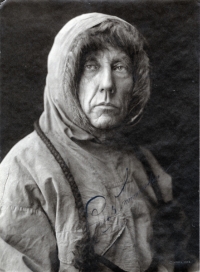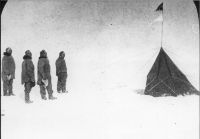1872 - 1928
 Roald Amundsen Photo: Norwegian Polar Institute
Roald Amundsen Photo: Norwegian Polar Institute
 14. desember 1911 på Sørpolen Photo: Norwegian Polar Institute
14. desember 1911 på Sørpolen Photo: Norwegian Polar Institute
Polar explorer, discoverer, researcher and pioneer of flight
Roald Amundsen was born in Borge near Sarpsborg. He began to study medicine, but when both his parents died, he abandoned his academic studies to dedicate his life to polar research. His first trip to polar regions was as first mate on Gerlache’s Belgian Antarctic expedition of 1897-1899.
The first to sail through the Northwest Passage
In the summer of 1903 Amundsen sailed from Oslo with the ship Gjøa. The aim of the expedition was to find the Northwest Passage, for which the English had been searching for 400 years. Amundsen had a scientific goal: he wanted to measure the earth’s magnetic field and determine its exact location. The expedition had a 23-month stopover in Gjøa Haven on King William Island. While there, Amundsen studied how the Inuit lived and gathered a prodigious amount of ethnographic material. In the spring of 1905, Gjøa sailed onward and emerged at the other end of the Northwest Passage in August 1906.
North Pole expedition becomes South Pole expedition
Amundsen started preparing for an expedition to the North Pole, but when both Frederick A. Cook and Robert E. Peary claimed to have reached the Pole, in 1908 and 1909, respectively, Amundsen secretly changed his plans. In Madeira he revealed that the expedition to the North Pole would go by way of the South Pole. The race was on with Robert F. Scott to see which of them would be the first man on the southernmost point on earth.Amundsen reached the South Pole 14 December 1911, five weeks before Scott, who died on the return journey.
The Maude expedition and scientific work
In 1918 Amundsen finally set off for the North Pole with the vessel Maud. The expedition was equipped for oceanographic, meteorological and geomagnetic research and was at the time the largest, most well equipped geophysical polar expedition that had ever been mounted. The expedition never reached its geographic destination, the North Pole, but the geophysical data that were collected and interpreted – mainly by H. U. Sverdrup – have given the Maud expedition the reputation of being one of the most important Arctic research expeditions of all time.
Aeronautical pioneer
Amundsen believed that the future of Arctic exploration was in the air. On 21 May 1925, accompanied by Lincoln Ellsworth, the son of an American millionaire, he took off northwards from Ny-Ålesund with two Dornier-Wal seaplanes, N 24 and N 25. They landed in an ice-free lead at 87°44’ N. One of the planes was damaged and ice closed up the lead. The two men spent three weeks making a 500-m long runway and managed to return to civilisation.
11 May 1926 the dirigible airship Norge started off on its transpolar flight over the Arctic with Amundsen, Nobile and Ellsworth onboard. The airship had been constructed by the engineer Umberto Nobile, a colonel in the Italian Air Force. They reached the North Pole after about 16 hours and landed at Teller in Alaska 14 May after a 72-hour flight. Their course had taken them through an as yet unexplored part of the Arctic and Amundsen could now say with certainty that it contained no large body of land. The last of the great unexplored blank spaces on the map had been eliminated.
Criticism and tragedy
Despite his trimuphs, Amundsen’s last years were marred by criticism that weighed heavily on him. He was also in precarious economic circumstances after having spent all he had on the expeditions. When Nobile’s airship Italia crashed north of Svalbard during an expedition, Amundsen immediately volunteered to participate in the search. 18 June 1928 he departed with a French Latham seaplane from Tromsø. Three hours later the last contact with the plane was heard; it probably crashed in the ocean and all six on board perished.
After his death, Amundsen was celebrated as a hero, and at noon on 14 December 1928, the same day as he had reached the South Pole in 1911, Amundsen was commemorated with two minutes’ silence while church bells tolled all over the country.

